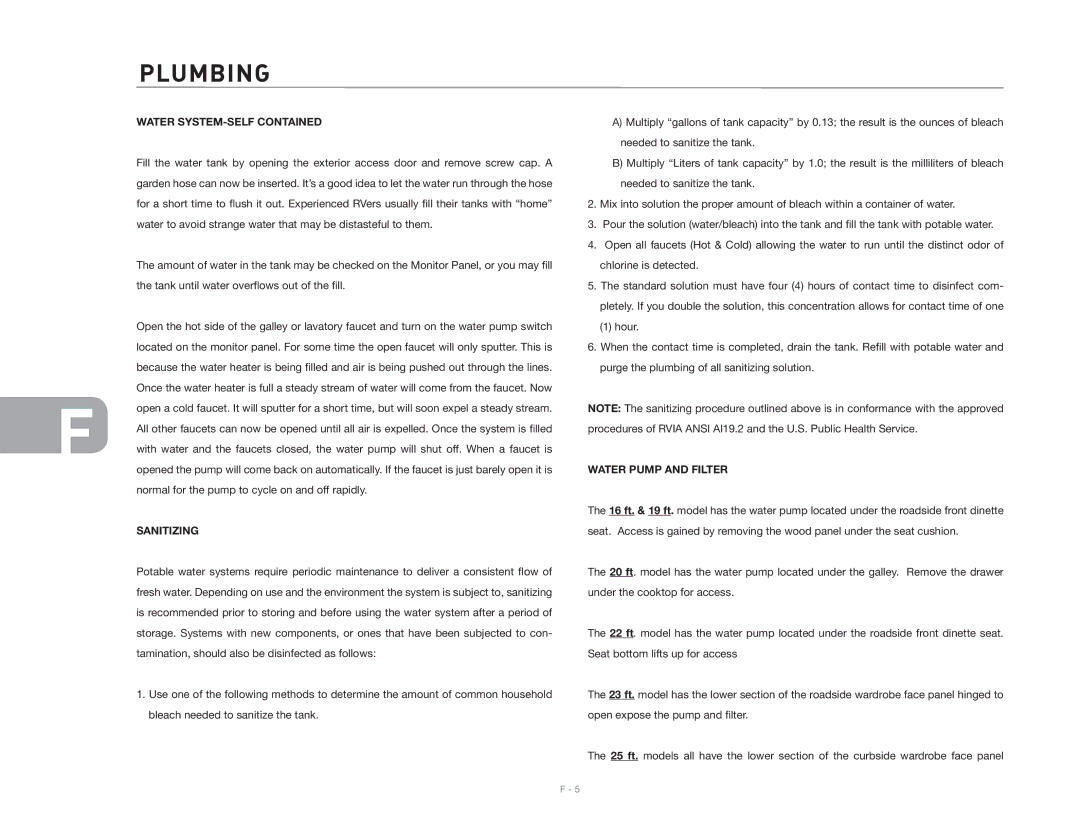
Plumbing
WATER SYSTEM-SELF CONTAINED
Fill the water tank by opening the exterior access door and remove screw cap. A garden hose can now be inserted. It’s a good idea to let the water run through the hose for a short time to flush it out. Experienced RVers usually fill their tanks with “home” water to avoid strange water that may be distasteful to them.
The amount of water in the tank may be checked on the Monitor Panel, or you may fill the tank until water overflows out of the fill.
Open the hot side of the galley or lavatory faucet and turn on the water pump switch located on the monitor panel. For some time the open faucet will only sputter. This is because the water heater is being filled and air is being pushed out through the lines. Once the water heater is full a steady stream of water will come from the faucet. Now
F open a cold faucet. It will sputter for a short time, but will soon expel a steady stream. All other faucets can now be opened until all air is expelled. Once the system is filled with water and the faucets closed, the water pump will shut off. When a faucet is opened the pump will come back on automatically. If the faucet is just barely open it is normal for the pump to cycle on and off rapidly.
SANITIZING
Potable water systems require periodic maintenance to deliver a consistent flow of fresh water. Depending on use and the environment the system is subject to, sanitizing is recommended prior to storing and before using the water system after a period of storage. Systems with new components, or ones that have been subjected to con- tamination, should also be disinfected as follows:
1.Use one of the following methods to determine the amount of common household bleach needed to sanitize the tank.
A)Multiply “gallons of tank capacity” by 0.13; the result is the ounces of bleach needed to sanitize the tank.
B)Multiply “Liters of tank capacity” by 1.0; the result is the milliliters of bleach needed to sanitize the tank.
2.Mix into solution the proper amount of bleach within a container of water.
3.Pour the solution (water/bleach) into the tank and fill the tank with potable water.
4.Open all faucets (Hot & Cold) allowing the water to run until the distinct odor of chlorine is detected.
5.The standard solution must have four (4) hours of contact time to disinfect com- pletely. If you double the solution, this concentration allows for contact time of one
(1)hour.
6.When the contact time is completed, drain the tank. Refill with potable water and purge the plumbing of all sanitizing solution.
NOTE: The sanitizing procedure outlined above is in conformance with the approved procedures of RVIA ANSI Al19.2 and the U.S. Public Health Service.
WATER PUMP AND FILTER
The 16 ft. & 19 ft. model has the water pump located under the roadside front dinette seat. Access is gained by removing the wood panel under the seat cushion.
The 20 ft. model has the water pump located under the galley. Remove the drawer under the cooktop for access.
The 22 ft. model has the water pump located under the roadside front dinette seat. Seat bottom lifts up for access
The 23 ft. model has the lower section of the roadside wardrobe face panel hinged to open expose the pump and filter.
The 25 ft. models all have the lower section of the curbside wardrobe face panel
F - 5
